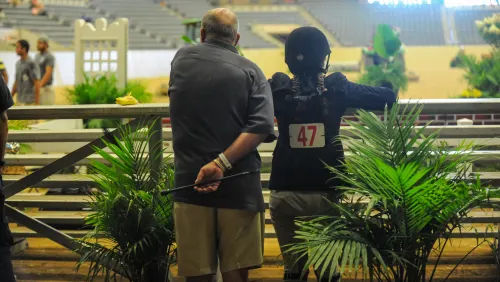It’s a rare event rider who isn’t nervous before cross-country. I’m sure it’s even worse for rodeo cowboys and for steeplechase jockeys. Strapping on all that protective gear and preparing to run at high speed over solid jumps is about as close as modern riders come to gearing up for armed battle.
In Shakespeare’s Henry V, it’s the night before the battle of Agincourt. The English and French armies are so close they can see each other’s fires and hear the sounds from each other’s camps:
“Steed threatens steed, in high and boastful neighs Piercing the night’s dull ear; and from the tents The armourers, accomplishing the knights, With busy hammers closing rivets up, Give dreadful note of preparation”
Getting riveted up in your armor to go charge another knight with a steel-tipped lance, mounted on a 1,500-pound horse, must focus your attention. Strapping on your spurs, your vest, your helmet and your medical armband is bad enough.
Early this past June, I was doing just that in the muddy parking area at the Green Mountain Horse Association (Vt.). Horses and riders would tear past my trailer at two-minute intervals, and a few minutes later most of them would come thundering down the finishing lane, mud-coated and exuberant. As I looked around me at my mostly silent and intent fellow riders making similar last-minute preparations, I was suddenly struck by how “un-knight-like” most of us looked.
Living near Dartmouth College, it’s not unusual to be sitting in a fast-food restaurant in Lebanon, N.H., when a busload of visiting athletes, the Middlebury College (Vt.) ski team, for example, invades the place. These men and women look the part. They’re lean, muscular and wind-burned. They’re young and tough and have just the requisite athletic swagger and arrogance.
Most of the people in my parking lot didn’t look anything at all like knights or a ski team. For many of those riders, the “sweet bird of youth” flew away a long time ago. There were a few hard-bodied kids mixed in the group, but not like at the Rolex Kentucky CCI.
ADVERTISEMENT
Most of these riders looked exactly like what they were. That is to say, they looked like parents and grandparents, teachers, computer operators, postal workers, doctors, receptionists, veterinarians and clerks. Their exterior appearance does very little to suggest that they’re risk-sport athletes, to differentiate them from the great mass of their fellow Americans who at the very same moment were shopping, driving cars, eating, drinking, reading in a chair, or getting their vicarious thrills from watching TV.
I had enough to do right then not to pursue my unprofound observation, but I’ve thought about it a good deal since.
What drives these seemingly normal men and women to risk life and limb, weekend after weekend? What makes them different from the great mass of their fellow citizens, who could more readily be described as safety seekers? Are they the Middlebury ski team all grown up, two, three or four decades later, still risk-bound after all these years?
Were they always like this, and gravitated to a sport that fulfilled that need, or is there something about a sport like eventing that brings out risky behavior?
Is it love of horses and wanting to be near them? It must be partly that, but there are many other safer ways to achieve that goal.
Is it a quest for fame and glory that derives from successful athletic achievement, a ribbon on the wall, their name in the Chronicle?
Is it the yearning for adventure that America’s 21st century opulence hasn’t completely managed to extinguish in the hearts and souls of all the people?
ADVERTISEMENT
Is it the thrill of galloping, the “need for speed,” the exquisite sensation of “hang time” over a big oxer drop fence, that more mundane horse sports just can’t provide?
Is it the unique camaraderie of eventing, where competitors still help other competitors? “Stay away from the left side of fence 12. The footing is all chewed up there, and it’s a much better approach on the right.”
Is it the need for challenge, a competitive urge, which propels them to try to excel ina sport that is as difficult to do well as eventing?
Is it the secret need for danger, that almost shameful desire for the “whiff of gun smoke?”
Something drives them. If you saw them on the streets in their normal clothes, they would look like average people, the kind who would go shopping on Saturday for the backyard barbecue that evening. In some hard-to-measure ways, event riders aren’t normal by the prevailing standards of our 21st century American culture.
Perhaps the risk takers in our midst are genetically coded hold-overs from a time not long past when every aspect of life was fraught with enormous danger.
Ethan Allen said, “The gods of the hills are not the gods of the valleys.” It’s not an easy thing for people with totally divergent world views to comprehend each other’s needs. At an intellectual level, safety seekers and risk takers can coexist perfectly well, but at a more visceral level they will never fully understand one another.














